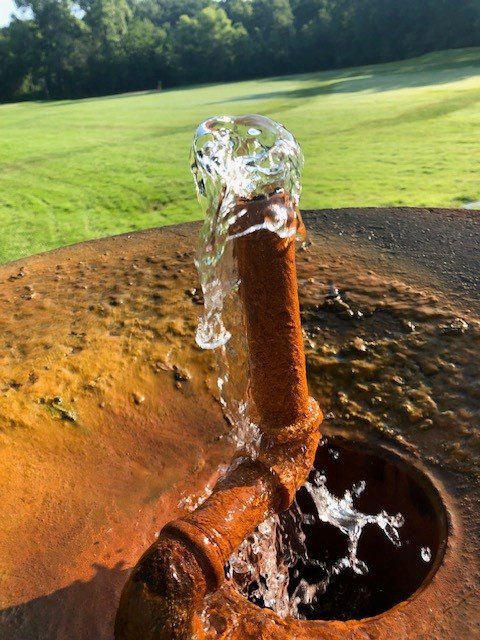One of the stops on the June Lakeside Loop bike ride was a demonstration by Stream Team volunteers. They talked about the various pollutants that are being monitored and demonstrated how the equipment is used. The conversation evolved to how “safe” the lake water is. Someone then asked about the drinking fountain on the Country Club golf course and if it was “safe.” Great Question!
Flowing Wells

I have heard that the Lake Maxinkuckee area used to have several flowing wells but most of them have been capped. This is substantiated by the Evermann and Clark study done in the early 1900s. There is a section in Volume 1 that lists all the flowing wells on the shores of the lake – about 50. (Thank you Jeff Kenney.)
“Beginning just north of Norris Inlet, flowing wells have been secured at irregular intervals all along the east shore and across the north end, the last one being at the Vandalia Railroad station at Culver.”
Kenney identified the Country Club well, at the time of the study, as belonging to Charles E. Coffin. I found it interesting that the water temperature of the wells listed in Evermann and Clark is between 51 – 54 degrees F. The temperature I observed, over 100 years later, was 54.6 degrees F.
Artesian Water is Special
People talk about these wells as being really good water so I was curious whether science could back that up. After getting permission from the superintendent of the Country Club golf course to test their fountain, I collected my samples. Since I wanted to test for arsenic, e. coli, nitrates and lead, I had to collect water in three different bottles.
I didn’t think there was any reason to test for iron – the red discoloration is a clear indicator of iron.

According to Encyclopedia Britannica, an artesian well is a well from which water flows, under natural pressure, without pumping.
That’s it!
Chemically and physically, artesian groundwater is not different than other groundwater, it just comes to the surface differently. The word artesian, properly used, simply refers to those instances where the water is confined under pressure below layers of relatively impermeable rock.
Test Results
E. coli < 1 MPN/100 mL
Total coliform < 1 MPN/100 mL
At examination time, this water was bacteriologically safe based on US EPA standards.
Arsenic 0.0125 mg/L
“When concentrations are greater than 0.010 mg/L, steps should be taken to reduce arsenic in drinking water because of concerns that long-term consumption of water with this level of arsenic may increase the risk of certain types of cancers.”
Interpreting Well Water Quality Results
A primary source of arsenic in well water is from water flowing through rocks and soil that are rich in arsenic, a naturally occurring element.
Arsenic can present in two different forms: arsenic 3 and 5. Arsenic 3, otherwise known as arsenite, is less toxic than arsenic 5, known as arsenate. This lab analysis did not differentiate between the different forms.
Lead 1.3 ug/L Maximum Contaminant Level is 15, so well within the safe level.
Nitrate <1 mg/L Maximum Contaminant Level is 10, so well within the safe level.
pH 7.10
Conclusion

People in the Culver community have been using this well for generations. I am merely providing the results of the water analysis. You can do your own research and make your own decisions on whether you feel comfortable using this as an occasional water source.
The U.S. Environmental Protection Agency’s (EPA) rules that protect public drinking water systems do not apply to privately owned wells. If you have a well, it is up to you to make sure that your water is safe to drink and the CDC recommends having your well water tested once a year.
Feel free to contact me if you have any questions on where to get sample bottles, what lab I used or what to test for.

Hi, I’m Debbie Palmer. I received a BS in Horticulture from Purdue University. Here at LMEF, I am responsible for outreach presentations, monitoring the lake and it’s wetlands, project manager for restoration and research projects, and act as a community resource for all things related to the well-being of Lake Maxinkuckee and its surrounding watershed. I completed Indiana Watershed Leadership Academy, volunteer with the Indiana Clean Lakes Program, Hoosier River Watch and Marshall County Lakes and Waters and serve as a Board Member for Indiana Lakes Management Society.


Recent Comments